Intrasoil (underground), drip irrigation.
Drip irrigation - ideal watering plants.
However, it is not always convenient to use a traditional system, where drip irrigation tubes are located on the surface of the soil. 
They interfere to conduct tillage, damaged equipment, workers, birds and animals. An important factor, and the safety of the drip system, ie protection against theft. For some plants, the presence of surface irrigation adversely affects the root system development, mainly when developing surface roots.
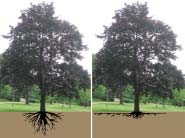 For these reasons, it is difficult to use surface drip irrigation system in the gardens and vineyards . Due to preferential proliferation of the root system in the surface soil layer surface roots significantly reduce wind resistance trees and perennial plants resistance to frost because of the threat of freezing the surface layer of the soil and roots death.
For these reasons, it is difficult to use surface drip irrigation system in the gardens and vineyards . Due to preferential proliferation of the root system in the surface soil layer surface roots significantly reduce wind resistance trees and perennial plants resistance to frost because of the threat of freezing the surface layer of the soil and roots death.
The landscaping and ladshaftnom design expedient to conceal drip irrigation tubes into the ground, which increases the aesthetic parameters, as well as the reliability and durability of the system.
When intrasoil irrigation significantly reduced labor costs. Drip irrigation system need not be removed at the end of the season and once again lay on the surface at the beginning of the next irrigation season.
Why not use drip irrigation in the underground version before?
To do this, there are a number of reasons. Home - rapid clogging roots outlet and labyrinth drip, after which the system stops working, as well as shortcomings in the construction of drippers themselves, restricting their life.
technology ROOTGUARD®
ROOTGUARD® - a promising new product for drip irrigation systems.

ROOTGUARD® - trademark owned Geoflow Inc. and produced at the factory Metzerplas under license.
ROOTGUARD® technology prevents the dropper from root penetration through long managed allocation of the soil preparation Treflan® , which ensures reliable operation of the drip irrigation system for many years.
Treflan® - local root growth inhibitor. The first underground irrigation systems it was used as an independent formulation which was added to irrigation water several times per season to slow down the growth of roots near droppers. This technology was the first step in the use of underground drip irrigation system. Treflan® non-toxic and is not considered harmful to the environment substance. It is absorbed by soil particles and does not penetrate into the ground water.
Dropper conventional type placed in the soil, require from 2 to 4 in the irrigation season with the addition of the drug Treflan® . Nevertheless, this does not provide a reliable guarantee against the penetration of roots in a dropper and requires a fairly large doses of herbicide.
Technology ROOTGUARD® became a revolutionary step in the development of subsurface drip irrigation. With its appearance, as well as the development of new, contemporary designs drips were overcome all the problems associated with the introduction of a wide practice of this kind of drip irrigation.
ROOTGUARD® advantages compared to conventional drip irrigation systems at underground:

- When using ROOTGUARD® not need to enter into the soil a significant dose treflan.
- ROOTGUARD® treflan uses more efficiently uniformly and economically as compared to its input in the form of solution.
- Easy to use. No additional labor costs.
- Significant cost savings and labor.
Why use subsurface drip irrigation:
- Significant water savings. Up to 50% of water is lost when the surface irrigation by evaporation, fogging, runoff and weathering.
- Minimal amount of water required for irrigation, also reduces the cost of the system as a whole, by the use of pumps and other equipment less power, and smaller diameter pipelines.
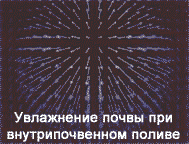

- Water and nutrients are delivered directly to the root zone providing a healthy plant growth.
- Safe and effective delivery of fertilizer to the roots of plants. This variant the fertilizer has additional advantages: do not fall in fertilizer runoff, for example, during the rainy season. This reduces chemical contamination of the soil.
- Enhancing soil aeration - fine particles of soil are not washed, the surface remains loose, soil compaction is reduced, improving the growth and development of the root system.
- Storing dry soil surface complicates the germination of weed seeds therefore need less herbicide and surface treatments soil cultivators.
- High efficiency. Less water evaporation, no waterlogging and becoming soaked, no weathering and cracking of the soil.
- No damage drip lines people (protection against vandalism and theft), animals and birds.
- The system does not interfere with the movement and the work of farm machinery.
- Location irrigation system in the soil reduces the harmful effects of solar radiation and weather, allowing you to operate the system without replacing for many years.
- It is possible to use secondary and waste (purified sewage) water, since no direct contact of water with the staff and plants.
- It reduces the risk of infection of plants by fungal diseases, since the surface of the soil, stems and leaves remain dry, which dramatically reduces the risk of the spread of disease.
- Ideal for irrigation of gardens and vineyards. The root system develops in the deeper soil horizons, and there are no obstacles for tilling, harvesting, and other equipment.
- The perfect solution for the needs of gardening. Drip irrigation tubes can be laid in the ground along any path, that is, if the site has a round or a complex shape with a lot of bends, the tube can follow the shape of the site and its position will not change.
- Ideal for field crops, so there is no need for the seasonally placement and collection tubes. Deep placement of tubes allows the processing of the soil when it is needed.
- Improving the quality and yield increase as a result of the high efficiency of irrigation method.
- Low operating costs and low labor costs.
Perennials
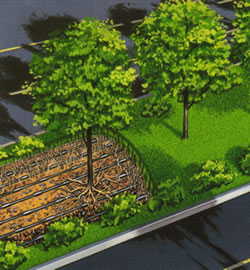 The use of underground drip irrigation for perennial crops is the most modern and progressive in horticulture, viticulture, gardening and landscaping sector.
The use of underground drip irrigation for perennial crops is the most modern and progressive in horticulture, viticulture, gardening and landscaping sector.
Located in the soil pipe made of technology ROOTGUARD®, allow to operate such systems reliably and for a long time.
The absence of the tubes on the surface of the soil makes it possible to use any machinery without damage to the irrigation system.
In terms of increasing the water deficiency, efficiency of such systems to use water in much smaller amounts, is also an undisputed advantage subterranean drip irrigation.
When using such systems in the gardening and landscaping, tubes, lying on the surface, and no not spoil the aesthetic perception of greenery.
Low operating costs make these systems cost efficient compared to conventional systems, in spite of a slight increase in costs in their construction.
High durability of irrigation systems. When the soil temperature about 15 degrees Celsius system works reliably at least 18 years. At higher temperatures, the selection Treflan® in soil is accelerated, and the life of the system decreases.
Drip irrigation systems based on technology ROOTGUARD® - it is the most progressive and modern solution for reclamation.
Design of subsurface drip irrigation.
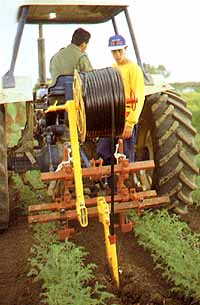
When designing you need to consider the following features of the system:
- Installing air vacuum valve at the highest level portion points.
- Design of distribution pipelines with relief.
- Correct calculation of depth Bookmarks pipelines with crops. For example, for irrigation of lawns, flower beds and for landscaping, the tube can be laid at a depth of
10-30 cm. For perennial plants bookmarks should be higher depth, and may be, depending on the plant species, from 25 to 70 centimeters. - The calculation of water needs. Water consumption for such systems is reduced by almost half. This reduces the diameter of distributing pipelines and pumping power plants.
- The system should be designed as a stationary sprinkler system, designed for continuous operation.
- irrigation system is recommended to be equipped with an automated water filtration systems, fertigation and irrigation automation.
In economic analysis and comparison of intra-automation system to the surface, to receive significant cost savings, since the subsurface system is in operation much longer, and seasonally operating costs are significantly lower than conventional drip irrigation systems.
Advantages of the system are particularly evident in the irrigated areas of a large area.
Laying of subsurface drip irrigation.
Lining pipes under the ground is carried out by means of special devices resembling cable layer of the structure.
There are several designs of machines. Their operating principle is roughly the same, but there are slight structural differences.

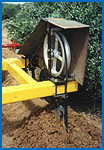
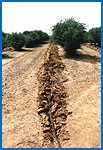
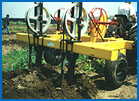
One option is simply mounted machines that can lay one or several tubes at the same time, depending on the number of hinged mechanisms for stacking.
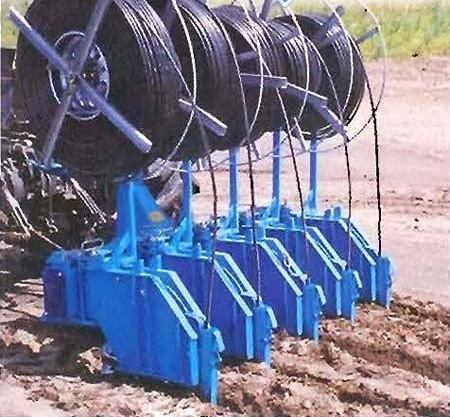
Multirow attachment device used for laying pipes 5 at a close distance.
Used for field crops, landscaping and sports grounds. (Parkland, football fields, golf courses, etc.)
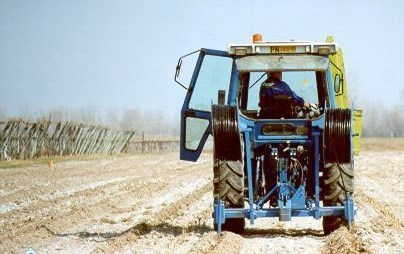
Two-row attachment for laying pipes in orchards and vineyards.
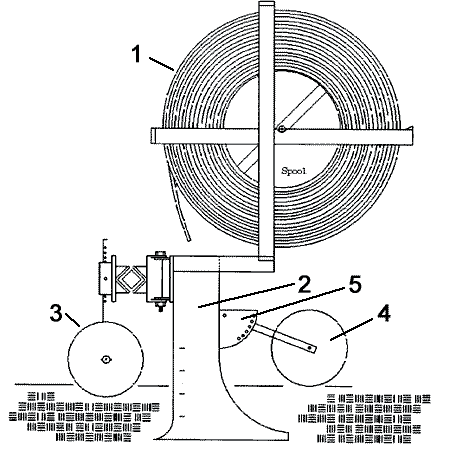
Schematic diagram of the device.
1. Drum with tube
2. Knife - pipelayer
3. Drive undercut soil
4. Wheel - limiter
5. depth adjusting apparatus Bookmarks
Our projects.
The first large project using this technology was implemented in 2010 in the South Kazakhstan region of the Republic of Kazakhstan.
subsurface drip irrigation system was installed in the farm area of 50 acres for irrigation persikovolgo and apple orchards. Along each row of tree seedlings with both sides were laid drip irrigation tube to a depth of about 50 cm. With the distance from the trunk of about 50-60 cm. The system was successfully operated and allows water the garden from wells with a sufficiently small flow rate of about 20 cubic meters of water per hour. This amount of water using conventional drip irrigation systems would not be enough for this economy.
Laying of underground drip irrigation tubes:

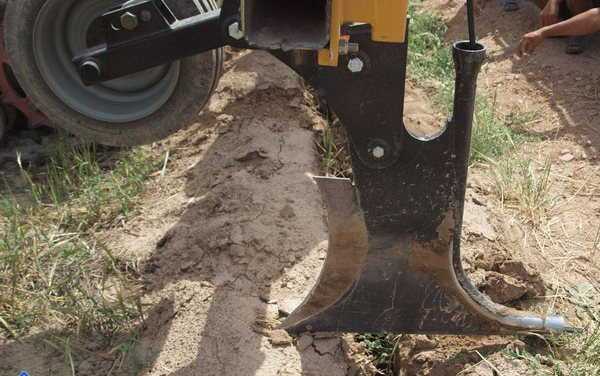

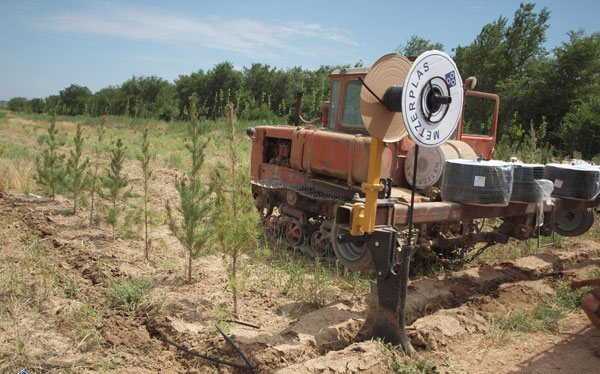
the water distribution unit 4 the irrigation zone. Such units in the field installed equipment 6.
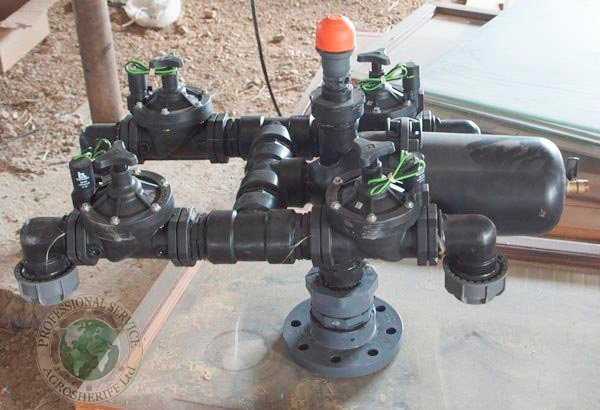
Installation filtration and fertigation away from the borehole.

Subsurface drip irrigation is also very effective, and in the vineyards.
More about this can be read HERE .
System of underground drip irrigation are becoming more common, especially in Australia and the United States. These countries have large areas of crops grown on such technology.